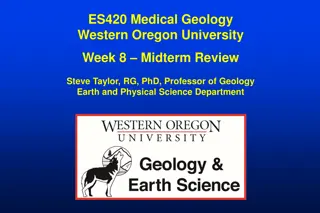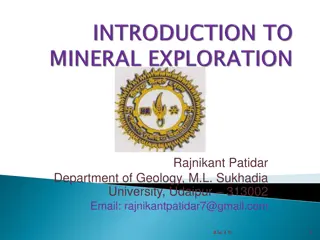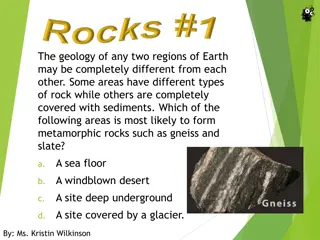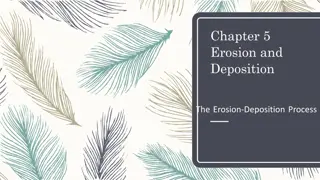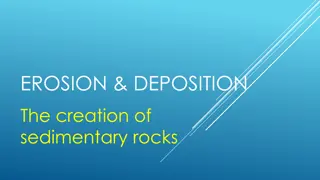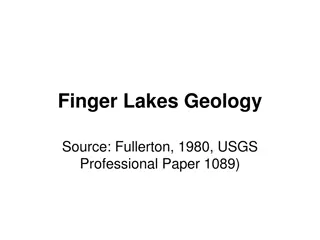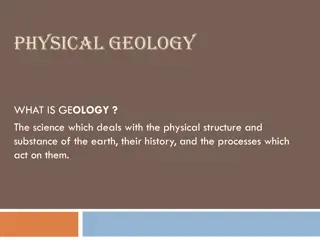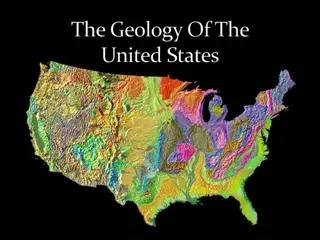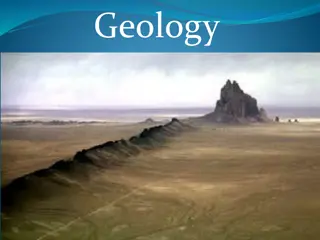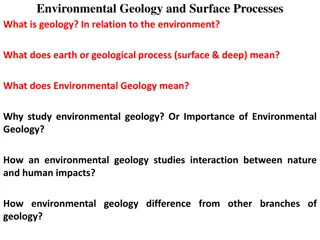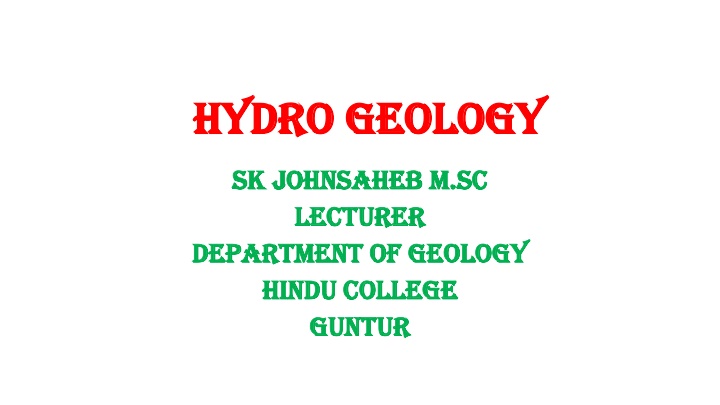
Hydrogeology and the Hydrological Cycle
Explore the principles of hydrogeology, the hydrological cycle, and the various components such as precipitation, evaporation, transpiration, infiltration, and runoff. Learn about the sources and classifications of groundwater in this informative guide.
Download Presentation

Please find below an Image/Link to download the presentation.
The content on the website is provided AS IS for your information and personal use only. It may not be sold, licensed, or shared on other websites without obtaining consent from the author. If you encounter any issues during the download, it is possible that the publisher has removed the file from their server.
You are allowed to download the files provided on this website for personal or commercial use, subject to the condition that they are used lawfully. All files are the property of their respective owners.
The content on the website is provided AS IS for your information and personal use only. It may not be sold, licensed, or shared on other websites without obtaining consent from the author.
E N D
Presentation Transcript
HYDRO GEOLOGY HYDRO GEOLOGY Sk Sk johnsaheb johnsaheb M.sc Lecturer Lecturer Department of geology Department of geology Hindu college Hindu college guntur guntur M.sc
HYDROLOGICAL CYCLE HYDROLOGICAL CYCLE Precipitation-Runoff+Infilteration+Evaporation+Transpiration Precipitation Precipitation It is the atmospheric discharge of water in the solid (hail,snow) or liquid (rain)form on the earths surface .some of the precipitation is intercepted by the vegetal canopy (interception) and the rest reaches the surface (through fall) . Evaporation Evaporation: Evaporation is the spontaneous process by which the water is transformed into vaporous state from the surface water bodies ,such as sea, lakes,rivers,tanks,glaciers etc.the rate of evaporation depends on several factors it increases with the decrease barometric pressure, increases in air and water temparatures,sunshine ,wind velocity,dryness of air and purity of water.
Transpiration: Transpiration: Part of precipitated water intercepted by plants is directly returned to the atmosphere by evaporation and part of the water reaching the ground and making up the soil moisture is evaporated through the leaves by transpiration . Transpiration rates may be extremely low in xerophytic plants in deserts but very height in hydrophyte plants of particular interest are the transpiration losses of potential ground water supplies through phreatophytes the habitually deplete water from the zone of saturation either directly[or] through the capillary fringe. Infiltration Infiltration : The infiltration characteristic of the soil determine the rate at which water received as rainfall [or water applied on the surface ]can move into the surface. The term percolation is used to denote the transit of infiltrated water through the unsaturated zone. Percolating water flows the path of least resistance ,travelling fast under gravity through the larger inter connected voids.
Runoff : Runoff : runoff may be defined as the water that falls on the ground flowing from a higher gradient to a lower one . If relatively impervious horizons above the water table out crop at the land surface , water may flow over them to reach streams as interflow . Runoff depends on a number factors namely 1. Dimensions and configurations of drainage basins. 2. The climatic conditions including intensity ,duration and areal distribution of precipitation. 3. moisture content of soil 4. topography and land surface slopes. 5. infiltration and permeability of soils and subsurface formations. 6.type and density of vegetation 7.aquifer streams relationships and 8. Human activities relating to land use urbanisation diversion of water
CHAPTER 2 ORIGIN, OCCURRENCE, VERTICAL DISTRIBUTION AND FORMS OF GROUND WATER Origin Sources and classifications of ground water Ground water is derived from several sources such as meteoric, connate , marine , juvenile etc.. MARINE WATER: Sea water [or] ocean which has invaded rocks and unconsolidated sediments which are in contact with the ocean Meteoric water : Ground water which originates from precipitation is called meteoric water. This water which is initially supplied by the rains [or] snow as a part of the hydrological cycle is known as meteoric water Connate water : The water that is entrapped in the rocks during their formations due to sedimentation in an aqueous environment is called connate water. Juvenile water : it is also called magmatic water which is of only theoretical importance . It is the water formed in the cracks.
Metamorphic water : water that has been associated with metamorphic rocks during the course of metamorphism is called metamorphic water OCCURRENCE OF GROUND WATER: ground water occurs in the earth crust in different forms depending upon the lithology, stratigraphy and structures Lithology is the physical makeup of mineral composition, grain size and grain packing of the sediments or rocks that make up the geological system. stratigraphy describes the geometrical and age relations between various groups, beds and formations in geological system of sedimentary origin . Structural features such as fractures, cleavages, folds, joints and faults are the geometrical properties of the geological system produced by deformation after deposition or crystallisation. The major geological units in terms of ground water occurrence and potentiality are as described below
Unconsolidated Fluvial deposits : fluvial deposits are the materials laid down by physical process in river channels [or] on food plains Aeolian deposits : sediments that are transported and deposited by wind are known as Aeolian deposits . Glacial deposits : they include glacial till , glacio fluvial sediments , glacio lacustrine sediments.
SEDIMENTARY ROCKS Sand stones : sand stone forms the best repositories of ground water. Sandstone beds owe their origin to various depositional environments. Carbonate rocks : carbonate rocks mostly consist of limestone , dolomites and dolomitic limestone . Geologically young carbonate rocks commonly have porosities that range from 20 to 50 percentage Shales : shales are the poorest aquifers . Although they are porous they are impermeable. CRYSTALLINE ROCKS Igneous and metamorphic: igneous and metamorphic rocks are relatively impermeable hence they serve as poor aquifers . Where such rocks occurs near the surface under weathered conditions. Volcanic rocks : volcanic rocks can form highly permeable aquifers.
VERTIFICAL DISTRIBUTION OF GROUND WATER VERTIFICAL DISTRIBUTION OF GROUND WATER The subsurface occurrence of ground water is divide into the following zones. Zone of aeration Soil water zone : water in the soil water zone exists at the zone of saturation except temporarily when excessive water reaches the ground surface as from rainfall or irrigation Intermediate zone : in intermediate vadose zone lies in between soil water zone and capillary zone . Capillary zone : this zone s also known as capillary fringe . It extends from water table upto the limit of capillary rise of water ZONE OF STURATION In the of saturation ground water fills all of the interstices. Hence the porosity provides a direct measure of the water contained for unit volume. Water table : the surface below which rocks a permanently ssturated with water is known a water table . The actual position of the water table show seasonal variations. During the rainy season more water is added than is lost . So water table rises and it wil be nearer to the surface .
FORMS OF GROUND WATER Wells :a hole dug into the ground to a considerable depth which reaches the water table is called a well. Artesian wells : the aquifer is permeable bed and is overlain underlain by permeable beds. Geysers : a geyser is a special type of thermal spring tat intermittently erupts a column of steam an hot water. REACHARGE AND DISCHARGE AREAS Areas can be delineated into recharge and discharge areas depending upon whether water in these areas is added to or abstracted from the zone of saturation. UTILIZATION OF GROUND WATER Ground water is an important source of water supply through out the world.
AQUIFERS Aquifers : a geological formation that yields significant quantities of water is defined as Aquifer. ex :unconsolidated sands and gravels Aquiclude : a saturated but relatively permeable material that doesn t yield appreciable quantities of water to wells. Ex :clay Aquifuge : a relatively impermeable formation neither containing nor transmitting water. Ex : solid granite , basalt etc.. Aquitard : a saturated but poorly permeable stratum that stops ground water movement and doesn t yield water freely to wells but it may transmit appreciable water to or from adjacent aquifers. TYPES OF AQUIFERS Unconfined aquifer : an unconfined aquifer is one in which water table varies in undulating form and in slope depending on areas of recharge and discharge pump age from wells and permeability.
Perched Aquifer : A special case of an unconfined aquifer involves perched water body as shown in figure . This occurs whenever a ground water body is separated from the main ground water by a relatively impermeable stratum of small areal extent and body of ground water. ex ;clay these sources yield only temporary or small quantities of water. Confined aquifer : confined aquifer is also known as artesian aquifers or pressure aquifers. Leaky aquifer : aquifers that are completely confined or unconfined occur less frequently than leaky aquifers. Idealized aquifer : for mathematical calculations of the storage and flow of ground water , aquifers assumed to be homogeneous and isotropic.
CHAPTER 6 POLLUTION OF GROUND WATER Definition Definition : pollution is a modification of a chemical , physical and biological properties of water , preventing its normal use in various applications. CAUSES AND SOURCES OF POLLUTION Domestic and urban pollution Sewer leakage : sanitary sewers are intended to be watertight . But inn reality leakage of sewage into the ground commonly occurs. Liquid waste : waste water in urban areas originate from domestic source and industries such water with out giving treatment is discharged into the surface water finally finds way into the ground water causing pollution. Solid water : land disposal of solid waste creates an important source of ground water pollution.
Septic tanks and cess pools : in urban and highly populated domestic areas leakage from septic tanks and cess pools cause ground water pollution on large scale. Roadways deicing salts : chloride ions from runoff from road deicing salts cause high chlorinity in ground water. AGRICULTURAL POLLUTION Irrigation return flows : approximately 1\2-2\3 water applied for irrigation of crops is consumed by evapo- transpiration. Animal waste : where animals are confined within a limited area of beef or milch production , large amount of animal wastes are deposited on the ground. Fertilizers and soil amendments : when fertilizers are applied to the agricultural land , a portion usually reaches through the soil and to the water table.
Pesticides and herbicides : insecticides , pesticides and herbicides are cumulative poisons in agricultural areas and cause ground water pollution. Industrial pollution Liquid waste : the major use of water in industrial plants is for cooling , sanitation , manufacturing of different products and processing . Tank and pipe line leakage : petroleum tanks and pipe lines of chemicals when subjected to structural failure , cause ground water pollution due to leakage. Mining activities :mines can produce a variety of ground water pollution problems. Oil field brines : the production of oil and gas is usually accompanied by the discharge of waste water n the form of brine . Trace metal pollution : in industrial areas heavy metals such as arsenic , cobalt , cadmium , chromium , copper , lead , iron , manganese and mercury enter into the waste water as traces and finally reaches the ground water table to cause pollution.
Spills and surface discharges : liquids discharge on the ground water surface in an uncontrolled manner can migrate downward to degrade ground water quality. Stock piles : solid materials are frequently stock piled near industrial plants construction sites and large agricultural operations. Other causes 1. pollution from salt water intrusion 2. pollution from surface water contamination 3.pollution from wells 4. pollution from atmospheric dissolved gases 5.pollution from radioactive substances 6.hih concentrations of fluorine etc ..
CHAPTER 7 EXPLORATION OF GROUND WATER Geological investigations : in ground water exploration among the three kinds of investigations geological investigation is the most important and the main deciding factor. Study of lithology : this refers to not only the outcrops of rock types occurring but also to their thickness altitude and their porosity and permeability characters . Study of topography : this refers to the occurrence of high lands such as hills , and low lands such as valleys.The water tsble will be roughly parallel to the surface i.e.occurring at a relatively higher levl in hilly regions and at the depth below valleys in low lands. Study of weathering : in hard rock areas surface occurrence of insitu rocks as base boulders without soil and subsoil zones is not suitable for tapping groundwater because they not only lack weathered zones but also joints and fractures which may occur on the surface shall become less prominent and disappear at a depth.
Study of geological structures : this refers to the trend or altitude of joints , cracks , faults , shear zones , folds etc .. Which not only contribute to secondary porosity but also act as a channel ways or guides the directions of movement of ground water.Syclinal folding accompanying suitable lithology leads to artesian conditions which are very much sought after in ground water exploration because they generally yield a copious supply of water. Remote sensing and aerial photographs : photographs of the earth taking from air craft or satellite at various electro magnetic wavelength ranges can provide useful information regarding ground water conditions of region. Stereoscopic examination of black&white aerial photographs hs gained important since observable patterns,colours&relief make it possible to distinguish differences in geology,soils,soil moisture,drainage,vegetation and land use. Hydrogeobotanical prospecting : hydrobotanical studies of vegetation in photographs [water loving] which transpire water from shallow water tables , define depths to ground water.They are good indicators of ground water .Halophytes,plants with a high tolerance for soluble salts and white efforescences of salt at ground water.Xerophytes Study of intrusive rocks : this refers to the occurrence , trend and extend of dolerite dykes , quartz veins etc..,These being hard and resistant may act s barriers to the normal flow of ground water.This results in the accumulation of ground water on one side of the intrusive only.Thus,it is common experience that in some places ground water may be plenty in a particular area and may be scarce in a nerby area. Geological mapping: this reveals most of the foregoing field data and hence is very important.In this,the actual mode of occurance of rocks along with the associate geological structures and intrusive are shown over the conour map of that area.
HYDROLOGICAL EXPLORATION Study of water table : in any regions the observations and estimation of the depth of the static water level in a number of wells and bore walls offer valuable informations about the relation position the nature of the slope of the water table ad the probable direction of flow of ground water in he area concerned Study of surface water bodies : This refers to the occurrence of networks of streams , ponds , lakes , reservoirs . Study of springs and see pages. Study of rainfall , climate . GEOPHYSICAL INVESTIGATIONS:Geophysical exploration is the scientific measurement of physical properties of the earths crust for investigaton of mineral deposits,geological structures or ground water resources.Orignisation concered with ground water employ geophysical methods.They are most useful when supplemented by surface investigations.Geophysical methods detect differences or anomalies of physical properties within the earths crust.Density,magnetism,elasticity commonly measured. Gravity method : Gravity methods represents a set of geophysical methods which make use of the natural gravity field of the earth. In the waterbearing zone density is less. Physical property : Density Principle : in gravity methods the nature of distribution of gravity , g on the surface is analysed.The gravity is influenced positively if the causative body is heavier,larger and occur at a shallow depth.Thus,in a particular region,if subsurface bodies whose densities are different from the normal value that is expected,it is possible to locate the heterogenous bodies in the subsurface.In the water bearing zone, density is less.
MAGNETIC METHOD Controlling property : Magnetic susceptibility principle The magnetic methods are based on the fact that the magnetic bodies present in the earth s subsurface contribute to the magnetic field of the earth.As the gravity methods,the contribution of the magnetic body is diretly proportional to the magnetic moment of the body and its size,and is inversely proportional to the depth of its occurrence.In general,when the magnetic field of the earth one of its components is measured on the surface bodies possessing magnetic moments different from those of the surroundings rocks contribute to the deviations in the measured quantities. In the water bearing zone the magnetic susceptibility is low. SEISMIC METHOD Principle : seismic methods of studying are based on the principle that the subsurface rock formations bear different elastic properties.Because of this,the velocities of propagation of sesmi waves through them change with changes in lithology.Measurement of seismic wave velocities of rock formations provides a scope to distinguish different subsurfaces litholigical units. ELECTRICAL RESISTIVITY METHODS Resistivity : Resistivity is a physical property of a substance [ like density].it is an inherent properly of the substance an is independent of size and shape of the substance.The resistivity is defined as the resistance offered by a unit cube of a substance to the flow of electric current when the voltage is applied at the opposite faces of the cube.
RESISTIVITIES OF DIFFERENT ROCK FORMATIONS 1. There are no fixed limits for resistivities of various rocks. 2. In igneous and metamorphic rocks the resistivities range from 10 power 2 to 10 power 8 ohm-m. In sedimentary and unconsolidated rocks the resistivities range from 10 power 0 to 10 power 4 ohm-m. In relatively porous formations,the resistivity is controlled more by water content and quality within th formation than by the rock resistivity. Clay minerals conduct electric current through their matrix.Therefore clay formations display lower resistivities than permeable alluvial aquifers.





